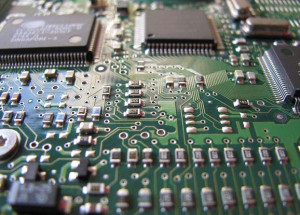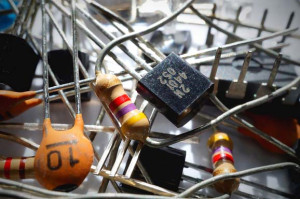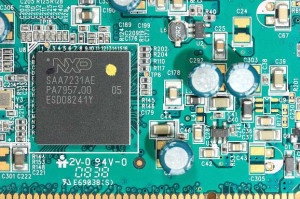Before constructing a PCB layout, engineers should take a few preparatory steps to streamline the layout creation. When designing digital and analog circuits, one crucial question is which technology to use. While numerous integrated circuits and discrete components come in various packages and sizes, the question frequently boils down to surface-mount technology (SMT) versus through-hole technology (THT). The right choice for an application may not always be inherently obvious, and this article covers a few key aspects to consider and approaches to assist with the decision.
Physical Differences Between SMD and THT
The most glaring difference between SMT and THT is the device sizing. Surface-mount devices are typically more compact than their through-hole counterparts, often resulting in more densely packed, smaller PCB designs that are cheaper to produce and assemble. However, the reduced pitch and condensed trace routing of SMT-based designs often makes reworking existing layouts more challenging, and adapting to changes in device availability can take more time.
Engineers may also prefer to choose THT components over SMT devices if repairability or manual assembly is necessary. Similarly, visual inspection of SMDs can be difficult or impossible — for example, when the mounting pins are obstructed.
Another crucial difference is the mechanical strength and resilience to environmental properties, such as pressure, extreme temperature, or prolonged exposure to humidity. Devices with direct user interaction usually benefit from the added mechanical strength that through-hole components offer. THT switches, bulky components, and physical connectors such as USB ports can be more reliable over time when the mounting pins reach through the PCB. In inter- and intra-PCB connections, surface-mount sockets and ribbon cables can help declutter design without sacrificing reliability.
The decreased size, weight, and proximity to the PCB may result in better resilience of surface-mount devices against vibrations and pressure. In comparison, the mounting pins of THT components may offer greater resilience to shear forces.
Ultimately, the choice depends on the target application, and engineers must also keep cost, production size, government regulations (medical, automotive, aviation, military), safety standards, and certifications (e.g., RoHS) in mind when choosing a technology.
Efficiency, Power Consumption, and Electrical Characteristics
While the overall choice of device is the most significant contributor to power consumption, choosing between SMT and THT can influence the overall efficiency of a circuit. Long signal paths, larger PCBs, and bulkier devices can add up, making a large difference especially in very low-power applications that must operate on a battery for long periods.
In high-frequency applications, shorter signal paths resulting from tighter component packing play a crucial role in minimizing potential entry points for noise, contributing to the preservation of signal integrity. Additionally, SMT components generally exhibit lower parasitic inductance and capacitance with increasing frequencies, thanks to their smaller device size and other factors, such as the absence of mounting leads. This reduction in parasitic elements is advantageous for maintaining signal quality and minimizing unwanted effects in high-frequency circuits.
Conversely, SMDs might not be the best choice in most high-power applications that need to withstand high currents and voltages. In these cases, engineers may want to opt for bulkier through-hole devices with higher voltage and amperage ratings, even though doing so means sacrificing a more compact board layout.
The target application generally dictates the technology to use. However, as a general guideline, choosing SMT devices over equivalent THT components is typically preferable whenever fast signaling, low losses, and low consumption are essential. Modern, low-power, high-frequency devices, such as DSPs or MCUs, might not be available in larger packages anyway. In contrast, THT still has its place in high-power and high-currency applications that favor reliability and high-power output over compactness.
Consider Heat Dissipation Requirements
Thermal management is vital in the context of high-current and high-power applications, and the process of designing a heat dissipation solution for a device can also influence the choice between SMT and THT devices.
The larger thermal mass and surface area of through-hole components usually result in those devices dissipating more residual thermal energy while maintaining reliable operation in high-power applications. In addition, the increased physical size of THT often makes mounting these devices to an external heat sink easier.
While SMDs may produce less heat than their exact THT equivalents, some SMT devices such as power FETs or microprocessors might still get considerably hot during operation. In these cases, engineers must consider how to dissipate the excess heat to keep the device under favorable operating conditions. SMDs are mounted close to the PCB’s surface, so designing a heat-dissipation pad with additional thermal relief vias might be required, and these structures often complicate the design and manufacturing process.
Manufacturability and Production Size
The question of whether to use SMDs or through-hole components will have a direct impact on the overall cost and manufacturing time of PCBs. Modern board designs, especially those for large-scale production of low-power consumer devices, might not benefit from using THT devices. SMD-only designs usually result in faster turnaround times due to less effort during manufacturing and increased reliability. However, external IO interfaces can be the exception.
In contrast, small-scale and prototyping production runs will generally not benefit from omitting through-hole components in terms of turnaround time and production cost. More densely packed designs that comprise mainly or exclusively SMDs can also make troubleshooting and debugging new designs more difficult.
In contrast, small-scale and prototyping production runs will generally not benefit from omitting through-hole components in terms of turnaround time and production cost. More densely packed designs that comprise mainly or exclusively SMDs can also make troubleshooting and debugging new designs more difficult.
The Bottom Line
Ultimately, there’s no one-size-fits-all solution when choosing between SMT and THT, and engineers must carefully evaluate their design concerning the target application, production size, and market. Regulations, laws, and safety rules may also dictate the use of one component over another.
There exist a few guidelines that can make the choice between SMDs and through-hole devices easier. THT parts often exhibit more substantial mechanical durability, increased heat dissipation, and higher voltage and current ratings. In contrast, SMT parts are generally smaller, more efficient, and better-suited for fast-switching, low-power applications than their exact through-hole counterparts.
Finally, the production of SMD-only PCBs can be cheaper and often results in faster turnaround times and a shorter time-to-market. In contrast, designs with THT components may be easier to debug, prototype, and service due to the increased physical size of the components.








